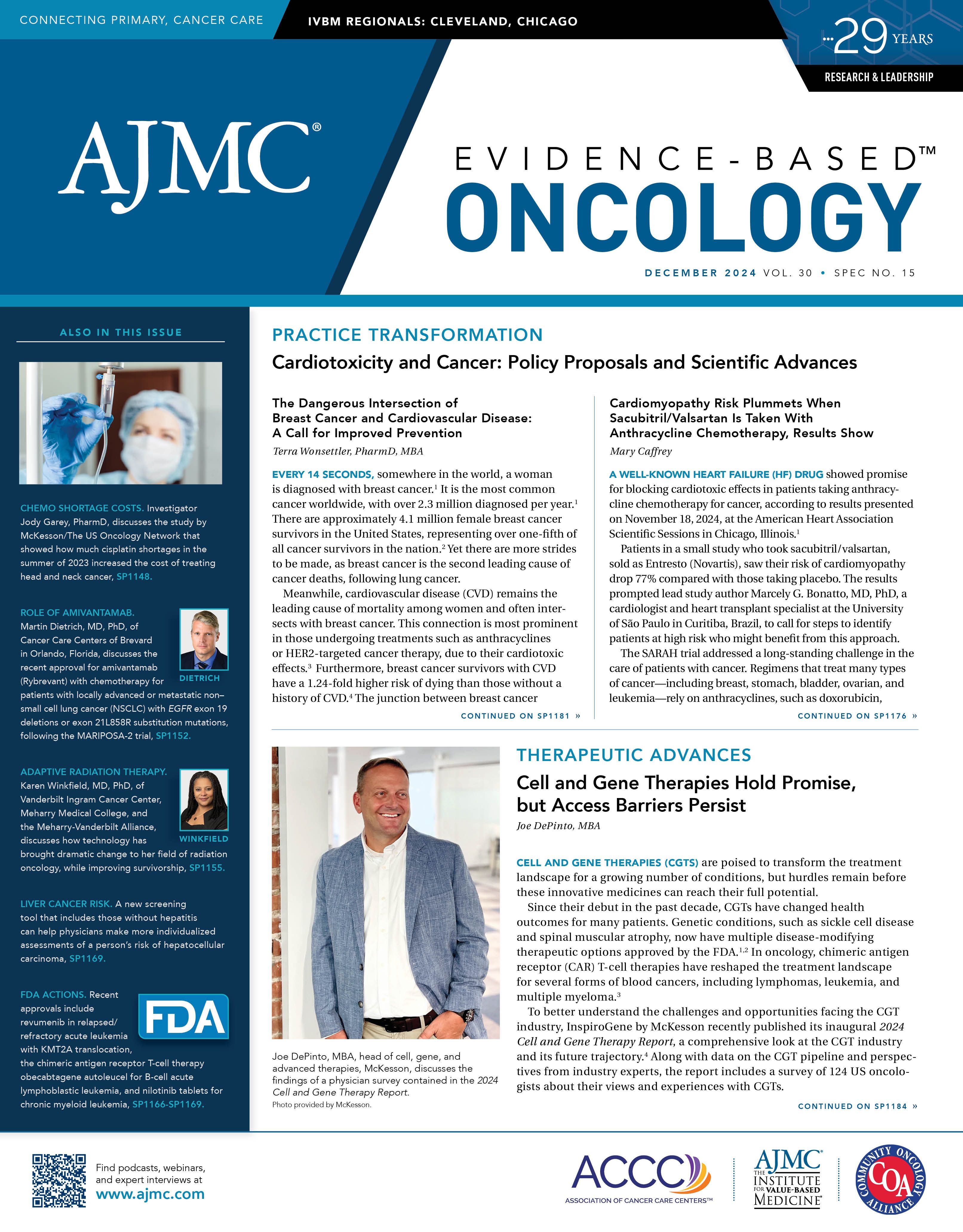- Center on Health Equity & Access
- Clinical
- Health Care Cost
- Health Care Delivery
- Insurance
- Policy
- Technology
- Value-Based Care
Cardiomyopathy Risk Plummets When Sacubitril/Valsartan Is Taken With Anthracycline Chemotherapy, Results Show
A well-known heart failure (HF) drug showed promise for blocking cardiotoxic effects in patients taking anthracycline chemotherapy for cancer, according to results presented on November 18, 2024, at the American Heart Association Scientific Sessions in Chicago, Illinois.
Patients in a small study who took sacubitril/valsartan, sold as Entresto (Novartis), saw their risk of cardiomyopathy drop 77% compared with those taking placebo. The results prompted lead study author Marcely G. Bonatto, MD, PhD, a cardiologist and heart transplant specialist at the University of São Paulo in Curitiba, Brazil, to call for steps to identify patients at high risk who might benefit from this approach.
Marcely G. Bonatto, MD, PhD | Image credit: AHA

The SARAH trial addressed a long-standing challenge in the care of patients with cancer. Regimens that treat many types of cancer—including breast, stomach, bladder, ovarian, and leukemia—rely on anthracyclines, such as doxorubicin, which are derived from enzyme-killing bacteria that are highly toxic and can cause HF (see Related Cover Story).2
The mechanisms of anthracyclines that target DNA in cancer can also cause heart damage, primarily due to the effect on topoisomerase 2β, which has become a focus of research. When this protein, also known as TOP2β, interacts with anthracyclines, it can lead to the DNA damage that
causes cardiomyopathy.3
Concern about the long-term effects of anthracyclines on survivors of cancer has increased in the past decade, because new classes of therapies have reduced cancer mortality.4 Newer drugs may be used later in the course of the disease or alongside chemotherapy in a multidrug regimen. At the same time, cancer is being diagnosed in younger adults due to rising obesity rates; these patients often have cancers where anthracyclines remain a mainstay of treatment.5
SARAH Trial Design
Investigators in SARAH identified patients at high risk of HF by measuring troponin levels during anthracycline treatment, according to the abstract and Bonatto’s presentation in a press briefing.1 Those at the 99th percentile were eligible for the study.
Patients were randomly assigned to receive either sacubitril/valsartan or placebo for 6 months; after starting with a dose of 24 mg or 26 mg twice a day, the doses were titrated up at the 2- and 4-week marks to reach optimal dosing of 97 mg to 103 mg twice a day. Patients were treated with the HF drug for 24 weeks. The study group was evaluated for biomarkers, echocardiographic (ECG) assessments, and cardiac magnetic resonance (CMR).1
Investigators reported that they calculated a sample size of 100 patients using estimated event rates of 35% in the placebo group and 12% in the study drug group, with 80% power and a type I error rate of 0.05. The primary end point was defined as the incidence of patients showing a greater than 15% reduction in global longitudinal stain (GLS) on the left ventricle after 6 months. Secondary end points included changes in biomarkers, GLS, and left ventricle ejection fraction (LVEF) after 6 months.1
SARAH Trial Results
The study was conducted at Erasto Gaertner Hospital in Curitiba, Brazil, from March 2022 to August 2024. The trial assigned 114 adults with cancer in a randomized fashion (1:1). The participants were undergoing chemotherapy at Erasto Gaertner. The group was 90% women, with 80.7% being treated for breast cancer, and the mean age was 51.7 years. Of this group, 92% were White, 7% self-identified as Black or multiracial, and 1% were Asian.
- Almost two-thirds (64%) had at least 1 comorbidity. Baseline GLS was –20.1% (range, –15.5% to –29%), and baseline LVEF was 64% (range, 53.1%-79.2%).
- The primary end point was met in 7.1% of patients receiving sacubitril/valsartan compared with 25% receiving placebo (HR, 0.23; 95% CI, 0.07-0.75; P < .015).
- The sacubitril/valsartan group had improved GLS by 2.5% compared with the placebo group, which saw a 7.6% decline (P = .015).
- At 6 months, LVEF as measured by CMR increased by 0.19% in the sacubitril/valsartan group and decreased by 3.47% in the placebo group (P = .011).
- There were no differences seen in biomarkers, ECG, or other CMR measures.
SARAH, Bonatto said at the press briefing, “is the first study to test sacubitril/valsartan as a protective cardio[vascular] strategy against anthracycline-induced cardiotoxicity, especially in patients [with] high risk.”
“It’s important to note that our strategy selected patients with cellular injury and therefore at high risk of developing cardiotoxicity,” she said. Pinpointing the patients who may benefit from sacubitril/valsartan “helps to avoid unnecessary exposure to adverse events and costs for patients [with] lower risk.”
Long-Term Follow-Up Needed
Tochi M. Okwuosa, DO | Image credit: Rush University, Chicago

Tochi M. Okwuosa, DO, professor of medicine at Rush University in Chicago, offered comment on the study, first explaining the separate mechanisms of sacubitril and valsartan. She noted that SARAH evaluated patients by CMR and ECG, which most studies have not done.
More research is needed, she said.
“We need longer term follow-up in the cardio-oncology population,” Okwuosa said. “The serum trial was just for 6 months. We need comparison between sacubitril/valsartan and valsartan alone. We need hard outcomes like heart failure hospitalizations, cardiovascular and overall mortality. We need real-world studies. And then cost and wide availability are also an issue.”
Strengths of the study include its focus on patients with high risk and the good safety profile, Bonatto said. There were no serious adverse events, she said, and fewer patients in the sacubitril/valsartan group completed the study with cardiac dysfunction. In response to the suggestion about using valsartan alone, Bonatto said in findings from animal studies, sacubitril/valsartan is superior to valsartan alone in preventing damage.
Limitations cited include the study’s small size, single location, and lack of diversity in the patient population.
References
1. Bonatto M, Ferreira S, Avila M, et al. Effects of sacubitril-valsartan on prevention of cardiotoxicity in high-risk patients undergoing anthracycline chemotherapy: a double-blind randomized placebo-controlled clinical trial – the SARAH trial. Abstract presented at: American Heart Association Scientific Sessions 2024; November 16-18, 2024; Chicago, IL. Abstract 4169654.
2. Volkova M, Russell R 3rd. Anthracycline cardiotoxicity: prevalence, pathogenesis and treatment. Curr Cardiol Rev. 2011;7(4):214-220. doi:10.2174/157340311799960645
3. Narezkina A, Narayan HK, Zemljic-Harfp AE. Molecular mechanisms of anthracycline cardiovascular toxicity. Clin Sci (Lond). 2021;135(10):1311-1332. doi:10.1042/CS20200301
4. Higher risk of heart failure seen in some cancers. National Cancer Institute. March 26, 2018. Accessed November 16, 2024. https://www.cancer.gov/news-events/cancer-currents-blog/2018/increased-heart-failure-risk
5. Siegel RL, Giaquinto AN, Jemal A. Cancer statistics, 2024. CA Cancer J Clin. 2024;74(1):12-49. doi:10.3322/caac.21820

Trends in Hospital Pricing for Vulnerable Emergency Department Users, 2021-2023
December 4th 2025Self-pay emergency department prices rose significantly from 2021 to 2023, especially at for-profit and system-affiliated hospitals, highlighting growing affordability challenges for uninsured and underinsured patients.
Read More
